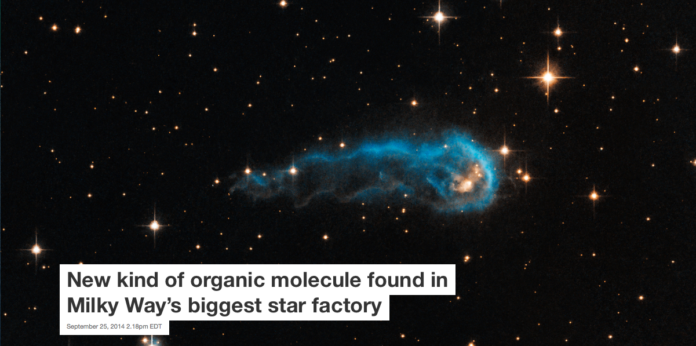
By Rene Breton, University of Southampton
One of the many unanswered questions about the origin of life on Earth is: where did organic molecules – those containing carbon, from which life as we know it is derived – come from? Given the conditions needed to create complex organic compounds, it was assumed that they were made on Earth. But chemical analysis of meteorites suggested that such chemistry could happen beyond Earth, too.
Life-supporting material, it seems, can be manufactured in sterile interstellar space, rather than needing the more cosy environment of a planet. The suggestion is that this interstellar medium harbours complex organic molecules – perhaps in abundance. New results just published in the journal Science by Arnaud Belloche of the Max Planck Institute for Radioastronomy and his colleagues add a piece of evidence to support this.
To find this evidence, Belloche observed the biggest star factory of our Galaxy using the newly-built Atacama Large Millimeter Array (ALMA) situated in the inhospitable Atacama plateau of Chile. This telescope collects microwave light coming from space and splits it into a multitude of colours using a spectrometer. Just like a household radio tunes radio stations, ALMA can scan a range of microwave channels.
Molecules at much lower temperatures than Earth – perhaps hundreds of degrees below room temperature – naturally emit light at energies corresponding to the radio waves and microwaves. Just like a slinky spring would oscillate vigorously if you shake it at just the right frequency, molecules bend, oscillate and rotate at very specific energies. The more complicated the molecule, the more diversified is the microwave light that it sends back. The exact mixture of light produced depends on factors such as the temperature and the density of the molecules. Analysing a microwave spectrum is therefore not a simple feat as it requires to disentangle a mess over hundreds of channels.

EFE/Ariel Marinkovic, CC BY
The data recorded by ALMA was compared against a database of molecular compounds recorded in Earth laboratories. The comparison revealed that Belloche had found iso-propyl cyanide, a molecule containing carbon, hydrogen and nitrogen. Just finding an organic chemical though is not a novel discovery. Over the years more than 180 types of chemicals have been observed, including ethanol, the active chemical in any alcoholic beverage.
Iso-propyl cyanide, however, is special. On Earth, it is used in the manufacturing of the amprolium, which is an anti-parasite poultry drug. But finding it in space is unusual because it is the first example of a branched molecule. Instead of containing a long carbon chain, which is found in simple propyl cyanide, the iso form is made of three straight carbons and an additional one branching out from the middle one.
This may look like an insignificant detail, but it is not. The pathways to create propyl cyanide from simpler molecules is not same in each configuration. Belloche found that the abundance of the two varieties of propyl cyanide in the active star-forming region is roughly equal.
However, the branched variety of propyl cyanide has never been found in non-star-forming molecular clouds. They contain only straight-chained organic molecules. It might therefore be that the level of complexity required to achieve amino acids such as those found in meteorites and some of which are branched, only prevail in star factories.
It is interesting to note that at the time of collecting their data, the ALMA telescope was only half-operational. The now-final telescope is made of ensemble of 66 antennas, most of them 12 meters in diameter, spreading over a distance reaching up to 16 km. It is designed to provide an order-of-magnitude improvement in sensitivity compared to the previous generation of millimetre-wavelength observatories. We can therefore expect more surprises to come in the next couple of years.
![]()
Rene Breton receives funding from the European Commission and the Science and Technology Facilities Council.
This article was originally published on The Conversation.
Read the original article.




















